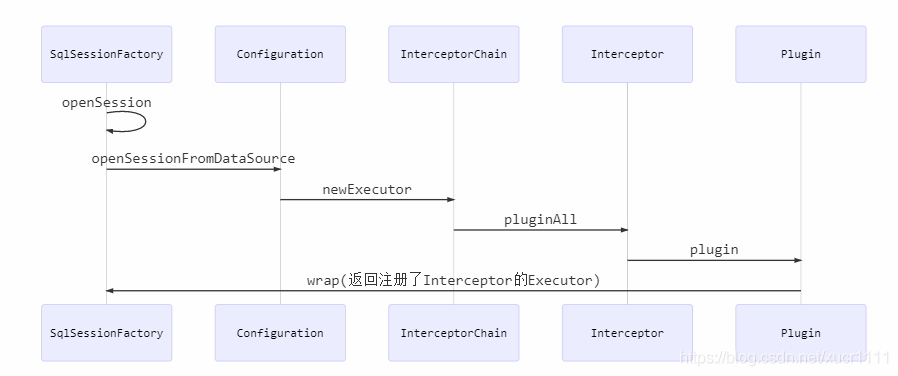淺談myBatis中的插件機(jī)制
插件的配置與使用
在mybatis-config.xml配置文件中配置plugin結(jié)點(diǎn),比如配置一個(gè)自定義的日志插件LogInterceptor和一個(gè)開源的分頁插件PageInterceptor:
<plugins> <plugin interceptor='com.crx.plugindemo.LogInterceptor'></plugin> <plugin interceptor='com.github.pagehelper.PageInterceptor'> <property name='helperDialect' value='oracle' /> </plugin></plugins>
插件的工作原理
借助責(zé)任鏈模式,定義一系列的過濾器,在查詢等方法執(zhí)行時(shí)進(jìn)行過濾,從而達(dá)到控制參數(shù)、調(diào)整查詢語句和控制查詢結(jié)果等作用。下面從插件的加載(初始化)、注冊和調(diào)用這三個(gè)方面闡述插件的工作原理。
過濾器的加載(初始化)
和其他配置信息一樣,過濾器的加載也會在myBatis讀取配置文件創(chuàng)建Configuration對象時(shí)進(jìn)行,相應(yīng)的信息存儲在Configuration的interceptorChain屬性中,InterceptorChain封裝了一個(gè)包含Interceptor的list:
private final List<Interceptor> interceptors = new ArrayList<>();
在XMLConfigBuilder進(jìn)行解析配置文件時(shí)執(zhí)行pluginElement方法,生成過濾器實(shí)例,并添加到上述list中:
private void pluginElement(XNode parent) throws Exception { if (parent != null) { for (XNode child : parent.getChildren()) { String interceptor = child.getStringAttribute('interceptor'); Properties properties = child.getChildrenAsProperties(); Interceptor interceptorInstance = (Interceptor) resolveClass(interceptor).getDeclaredConstructor().newInstance(); interceptorInstance.setProperties(properties); configuration.addInterceptor(interceptorInstance); } }}
過濾器的注冊
可以為Executor、ParameterHandler、ResultSetHandler和StatementHandler四個(gè)接口注冊過濾器,注冊的時(shí)機(jī)也就是這四種接口的實(shí)現(xiàn)類的對象的生成時(shí)機(jī),比如Executor的過濾器的注冊發(fā)生在SqlSessionFactory使用openSession方法構(gòu)建SqlSession的過程中(因?yàn)镾qlSession依賴一個(gè)Executor實(shí)例),ParameterHandler和StatementHandler的過濾器發(fā)生在doQuery等sql執(zhí)行方法執(zhí)行時(shí)注冊,而ResultHandler的過濾器的注冊則發(fā)生在查詢結(jié)果返回給客戶端的過程中。以Executor的過濾器的注冊為例,經(jīng)過了這樣的過程:

現(xiàn)在詳細(xì)的分析一下Plugin的wrap這個(gè)靜態(tài)的包裝方法:
public static Object wrap(Object target, Interceptor interceptor) { // 從定義的Interceptor實(shí)現(xiàn)類上的注解讀取需要攔截的類、方法 Map<Class<?>, Set<Method>> signatureMap = getSignatureMap(interceptor); // Executor、ParameterHandler、ResultSetHandler、StatementHandler Class<?> type = target.getClass(); // 從當(dāng)前執(zhí)行的目標(biāo)類中進(jìn)行匹配,過濾出符合當(dāng)前目標(biāo)的的過濾器 Class<?>[] interfaces = getAllInterfaces(type, signatureMap); if (interfaces.length > 0) { // 動態(tài)代理生成Executor的代理實(shí)例 return Proxy.newProxyInstance(type.getClassLoader(), interfaces, new Plugin(target, interceptor, signatureMap)); } return target;}
上述代碼中的getSignatureMap方法是解析Interceptor上面的注解的過程,從注解中讀取出需要攔截的方法,依據(jù)@Signature的三個(gè)變量類、方法method和參數(shù)args就能通過反射唯一的定位一個(gè)需要攔截的方法。
private static Map<Class<?>, Set<Method>> getSignatureMap(Interceptor interceptor) { Intercepts interceptsAnnotation = interceptor.getClass().getAnnotation(Intercepts.class); if (interceptsAnnotation == null) { throw new PluginException( 'No @Intercepts annotation was found in interceptor ' + interceptor.getClass().getName()); } Signature[] sigs = interceptsAnnotation.value(); Map<Class<?>, Set<Method>> signatureMap = new HashMap<>(); for (Signature sig : sigs) { Set<Method> methods = signatureMap.computeIfAbsent(sig.type(), k -> new HashSet<>()); try { Method method = sig.type().getMethod(sig.method(), sig.args()); methods.add(method); } catch (NoSuchMethodException e) { throw new PluginException('Could not find method on ' + sig.type() + ' named ' + sig.method() + '. Cause: ' + e, e); } } return signatureMap;}
而getAllInterfaces方法是依據(jù)不同的目標(biāo)對象(Executor等四種)進(jìn)行過濾的過程,只給對應(yīng)的目標(biāo)進(jìn)行注冊:
private static Class<?>[] getAllInterfaces(Class<?> type, Map<Class<?>, Set<Method>> signatureMap) { Set<Class<?>> interfaces = new HashSet<>(); while (type != null) { for (Class<?> c : type.getInterfaces()) { if (signatureMap.containsKey(c)) {interfaces.add(c); } } type = type.getSuperclass(); } return interfaces.toArray(new Class<?>[interfaces.size()]);}
至此,實(shí)際使用的Executor對象將是通過動態(tài)代理生成的Plugin實(shí)例。
過濾器的調(diào)用
在第二步中完成了過濾器的注冊,在實(shí)際調(diào)用Executor時(shí),將由實(shí)現(xiàn)了InvocationHandler接口的Plugin實(shí)例進(jìn)行接管,對Executor相應(yīng)方法方法的調(diào)用,將實(shí)際上調(diào)用動態(tài)代理體系下的invoke方法:
public Object invoke(Object proxy, Method method, Object[] args) throws Throwable { try { Set<Method> methods = signatureMap.get(method.getDeclaringClass()); if (methods != null && methods.contains(method)) { Object result=interceptor.intercept(new Invocation(target, method, args)); return result; } return method.invoke(target, args); } catch (Exception e) { throw ExceptionUtil.unwrapThrowable(e); }}
如前所述,插件的工作原理是基于責(zé)任鏈模式,可以注冊多個(gè)過濾器,層層包裝,最終由內(nèi)而外形成了一個(gè)近似裝飾器模式的責(zé)任鏈,最里面的基本實(shí)現(xiàn)是CachingExecutor:

從InterceptorChain的pluginAll方法可以看出這個(gè)結(jié)構(gòu)的構(gòu)造過程:
public Object pluginAll(Object target) { for (Interceptor interceptor : interceptors) { // 從這可以看出過濾器的傳遞的過程:動態(tài)代理實(shí)例由內(nèi)而外層層包裝,類似于與裝飾器的結(jié)構(gòu),基礎(chǔ) 實(shí)現(xiàn)是一個(gè)Executor target = interceptor.plugin(target); } return target;}
這種由內(nèi)而外的包裝的棧結(jié)構(gòu)從外向內(nèi)層層代理調(diào)用,完成了責(zé)任鏈任務(wù)的逐級推送。從這個(gè)注冊過程可以看到,在list中越前面的Interceptor越先被代理,在棧結(jié)構(gòu)中越處于底層,執(zhí)行的順序越靠后。造成了注冊順序和執(zhí)行順序相反的現(xiàn)象。
插件的典型案例:PageHelper
pagehelper是一個(gè)實(shí)現(xiàn)物理分頁效果的開源插件,并且在底層通過Dialect類適配了不同的數(shù)據(jù)庫,其主要作用是攔截sql查詢,構(gòu)造一個(gè)查詢總數(shù)的新的以'_COUNT'結(jié)尾的新sql,最終再進(jìn)行分頁查詢。
自定義插件
定義Interceptor接口的實(shí)現(xiàn)類并在其上使用@Intercepts和@Signature注解進(jìn)行過濾的類和方法,比如定義一個(gè)打日志的插件:
@Intercepts({@Signature(type = Executor.class, method = 'query', args = { MappedStatement.class, Object.class,RowBounds.class, ResultHandler.class }),@Signature(type = Executor.class, method = 'query', args = { MappedStatement.class, Object.class,RowBounds.class, ResultHandler.class, CacheKey.class, BoundSql.class }), })public class LogInterceptor implements Interceptor {@Overridepublic Object intercept(Invocation invocation) throws Throwable {System.out.println('進(jìn)入了自定義的插件過濾器!');System.out.println('執(zhí)行的目標(biāo)是:' + invocation.getTarget());System.out.println('執(zhí)行的方法是:' + invocation.getMethod());System.out.println('執(zhí)行的參數(shù)是:' + invocation.getArgs());return invocation.proceed();}}
@Intercepts注解中包含了一個(gè)方法簽名數(shù)組,即@Signature數(shù)組,@Signature有三個(gè)屬性,type、method和args分別定義要攔截的類、方法名和參數(shù),這樣就可以通過反射唯一的確定了要攔截的方法。type即為在工作原理分析中提到的Executor、ParameterHandler、ResultSetHandler和StatementHandler,method配置對應(yīng)接口中的方法。
到此這篇關(guān)于淺談myBatis中的插件機(jī)制的文章就介紹到這了,更多相關(guān)myBatis 插件機(jī)制內(nèi)容請搜索好吧啦網(wǎng)以前的文章或繼續(xù)瀏覽下面的相關(guān)文章希望大家以后多多支持好吧啦網(wǎng)!
相關(guān)文章:
1. SQL Server數(shù)據(jù)庫連接查詢和子查詢實(shí)戰(zhàn)案例2. Access創(chuàng)建一個(gè)簡單MIS管理系統(tǒng)3. Microsoft Office Access隱藏和顯示字段的方法4. 讓SQL Server也能使用2G以上內(nèi)存5. DB2 9(Viper)快速入門6. How to access eclipse workspace?7. SQLSERVER 臨時(shí)表和表變量的區(qū)別匯總8. SQL語句中的ON DUPLICATE KEY UPDATE使用9. mybatis plus代碼生成工具的實(shí)現(xiàn)代碼10. Microsoft Office Access凍結(jié)字段的方法

 網(wǎng)公網(wǎng)安備
網(wǎng)公網(wǎng)安備